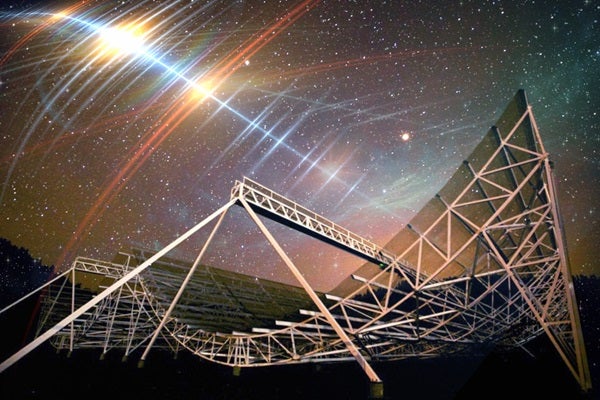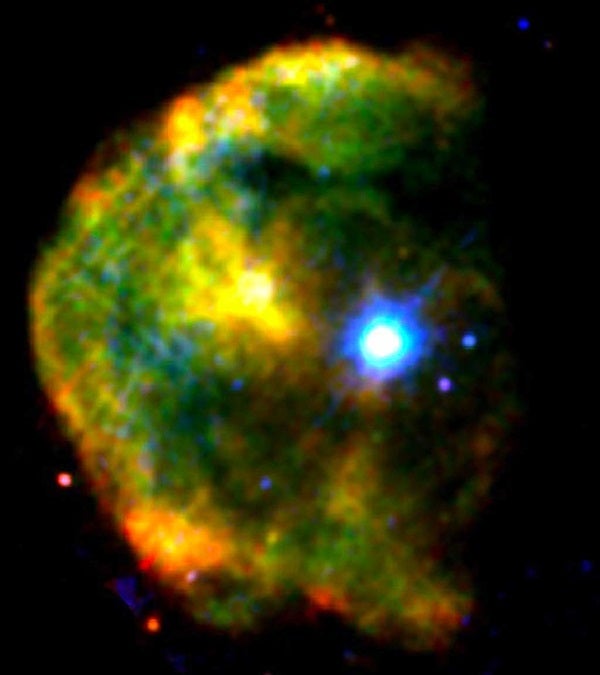Fast radio bursts (FRBs) are some of the most enigmatic radio signals in the universe. First, they are brief. Typically, an FRB lasts just a fraction of a second. They are also bright — so bright they can be seen in distant galaxies, with one FRB briefly emitting more energy than the Sun produces in a day. Third, FRBs have an extreme diversity in their signals: Some repeat with regularity while others are only ever seen once. Finally, their origins are disputed, while some FRBs come from a breed of stellar remnants known as magnetars, scientists aren’t sure if they account for every signal.
And although many thousands of FRBs have been recorded in recent years, the field is still in a stage where a single event can be special enough to turn our understanding of FRBs on its head.
Enter FRB 20191221A, which was spotted in late 2019 by the Canadian Hydrogen Intensity Mapping Experiment (CHIME), a radio telescope in British Columbia, Canada, that has found many of the most notable FRBs since it began operations in 2018. And FRB 20191221A is no exception.
The CHIME collaboration reported their discovery in the journal Nature on July 13 because this FRB has several unique features. First, it was the longest-duration FRB signal ever recorded. While most FRBs last a fraction of a second, FRB 20191221A lasted roughly three seconds, about a thousand times longer than the average FRB.
If that wasn’t unusual enough, astronomers discovered there was structure within the FRB pulse itself. Specifically, hidden within the signal were at least nine distinct peaks of noise that had startling regularity. “These peaks came at a precise period of about 0.2 seconds,” co-author Daniele Michilli, who is a postdoc at the MIT Kavli Institute for Astrophysics and Space Research, tells Astronomy. While Michelli and other astronomers have found several FRBs that have had components embedded in the FRB signal itself in the past, FRB 20191221A is unique. According to Michilli, “this is the first time the signal itself is periodic.”
Murky origins
Finding such a regular sub-structure is particularly exciting to astronomers because it means what created the FRB must be periodic. Which helps them rule out some suspected targets right away. For example, the origin of the FRB can’t be a supernova explosion, since that is a one-off event that wouldn’t repeat regularly. Further, the timing of the sub-structure signal within FRB 20191221A is very reminiscent to that seen from neutron stars (dense stellar remnants) in our own galaxy.
Some rapidly spinning neutron stars, called pulsars. give off regular radio pulses on these time scales. But even though they tend to rotate more slowly, their highly magnetic cousins, magnetars, can also exhibit this periodicity. “And we think this new signal could be a magnetar or pulsar on steroids,” explained Michilli in a press release. Because while the analysis shows FRB 20191221A might originate from a magnetar located within a turbulent environment of ionized gas, the intensity of the signal is over a million times brighter than any seen before from a magnetar in our own Milky Way.
Unfortunately, so far it seems like FRB 20191221A might be an isolated event. While many FRBs have been observed to repeat from the same location days or months later, no repeat signals have been detected from FRB 20191221A since that initial exciting burst in 2019. Why some FRBs are sporadic is not entirely clear. But magnetars in our own galaxy can be highly variable in the strength of their outbursts. So it’s possible that the CHIME telescope was exceptionally lucky in its timing and orientation to catch this especially bright burst.
Furthermore, the precise origin of the signal remains unknown. While they can confirm the signal came from a galaxy billions of light-years away from our Milky Way, the CHIME telescope field of view is such that astronomers can only identify the origin of an FRB to a patch of sky equivalent to the size of a Full Moon. This effectively means that astronomers can’t precisely pin down the location of the host galaxy responsible for the signal.
Thankfully, this might not be the case for long. Currently, the CHIME collaboration is constructing three additional “outrigger” telescopes in British Columbia, California, and West Virginia, supported by approximately $10 million in grants from the Gordon and Betty Moore Foundation. Working in conjunction with the original CHIME instrument, the combined telescopes will allow the collaboration to pinpoint the location of every FRB signal to an area of sky the size of a quarter held at roughly 25 miles away. Astronomers hope to start getting the first data from the outrigger stations within the next year or two. At which time, if FRB 20191221A bursts again, they’ll be ready.
Yvette Cendes is a radio astronomer at the Center for Astrophysics | Harvard & Smithsonian. You can follow her on Twitter @whereisyvette.











